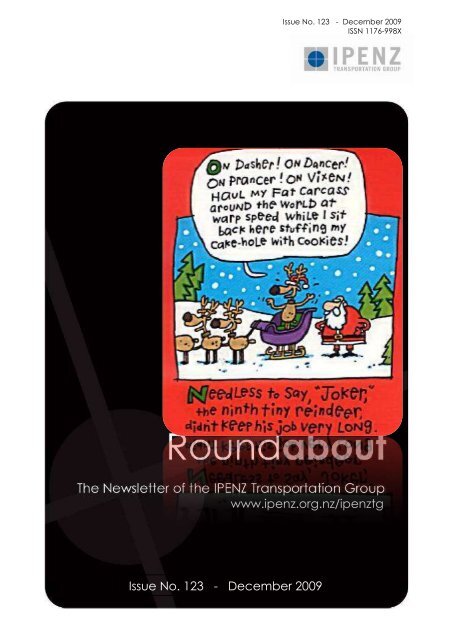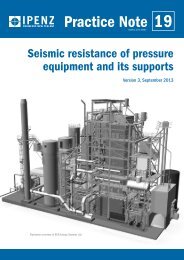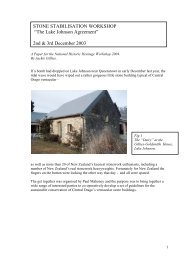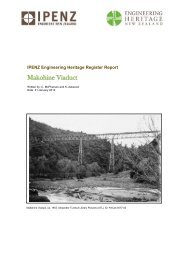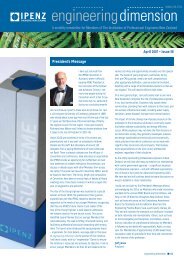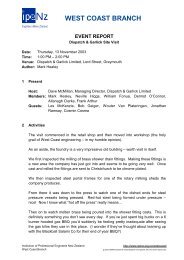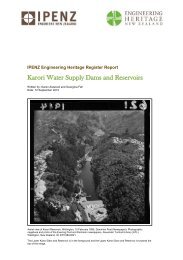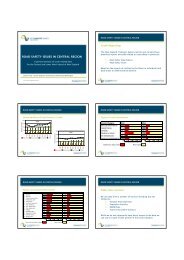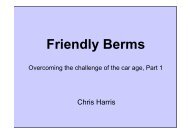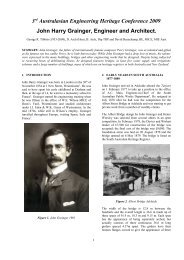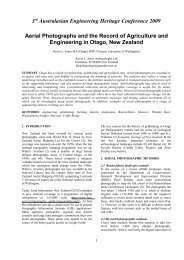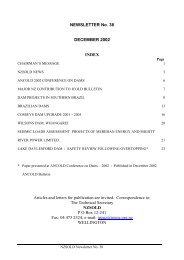Roundabout 123 Dec 2009 - ipenz
Roundabout 123 Dec 2009 - ipenz
Roundabout 123 Dec 2009 - ipenz
Create successful ePaper yourself
Turn your PDF publications into a flip-book with our unique Google optimized e-Paper software.
www.<strong>ipenz</strong>.org.nz/<strong>ipenz</strong>tg<br />
Issue No. <strong>123</strong> - <strong>Dec</strong>ember <strong>2009</strong><br />
Issue No. <strong>123</strong> - <strong>Dec</strong>ember <strong>2009</strong><br />
ISSN 1176-998X
Table of Contents<br />
CHAIRMAN’S CHAT ....................................................................................................................................................... 3<br />
EDITORIAL ....................................................................................................................................................................... 4<br />
LETTERS TO THE EDITOR .......................................................................................................................................... 5<br />
MEMBERS INFORMATION ........................................................................................................................................... 6<br />
NEW MEMBERS .............................................................................................................................................................. 6<br />
SEASON GREETINGS ..................................................................................................................................................... 7<br />
A WHEEL ON EACH CORNER ......................................................................................................................................... 7<br />
SIDE THRUST GAUGES .................................................................................................................................................. 8<br />
NEW NEWS ON OLD MEMBERS (SNOOPY) ................................................................................................................... 8<br />
APPLICATION FORM ....................................................................................................................................................... 9<br />
IPENZ TG CONFERENCE: 14 – 17 MARCH 2010 ................................................................................................. 10<br />
MEMBERS ARTICLES ................................................................................................................................................. 11<br />
IPENZ TRANSPORTATION GROUP NATIONAL COMMITTEE – A NEW STRUCTURE? ................................................. 11<br />
URBAN TRANSPORT CONGESTION REMEDIES ............................................................................................................ 12<br />
23 NOVEMBER <strong>2009</strong>.................................................................................................................................................... 13<br />
HOW YOU WANT TO RECEIVE ROUNDABOUT ............................................................................................................. 14<br />
GRAB THE CRAMPONS BOYS – STEEP INCLINE AHEAD.............................................................................................. 15<br />
INTELLIGENT TRANSPORT SYSTEMS SUMMIT <strong>2009</strong> IN MELBOURNE – 18 TO 20 NOVEMBER <strong>2009</strong> ......................... 16<br />
PROFESSION IN PRINT .............................................................................................................................................. 17<br />
CONFERENCES, WORKSHOPS AND OTHER REASONS TO MIX WITH YOUR PEERS ............................ 20<br />
FUNDAMENTALS OF TRAFFIC ENGINEERING COURSE ................................................................................................ 23<br />
SITUATIONS VACANT ................................................................................................................................................ 24<br />
YOUR REPRESENTATIVES ....................................................................................................................................... 27<br />
BRANCH CHAIRS AND SECRETARIES .......................................................................................................................... 27<br />
MANAGEMENT COMMITTEE ......................................................................................................................................... 27<br />
THE FINAL WORD ........................................................................................................................................................ 28<br />
<strong>Roundabout</strong> International Standard Serial Number: 1176-998X<br />
Cover Image: http://www.lifevesting.com/blog/wp-content/uploads/2008/12/funnychristmas-cartoon.jpg<br />
2 <strong>Roundabout</strong> No.<strong>123</strong> <strong>Dec</strong>ember 09
Chairman’s Chat<br />
Chairman’s Chat<br />
The National Committee is making good progress on developing a draft Strategic Plan for the Group. The<br />
National Committee and Branch Chairs will be discussing this initial draft in mid <strong>Dec</strong>ember to ensure that it is<br />
comprehensive and covers all areas of importance to the IPENZ Transportation Group. Following this, the<br />
National Committee will look to have a final draft forwarded to all members for review and feedback and it is<br />
imperative that you take the opportunity to do so. The aim is to have final Strategic Plan adopted at the AGM<br />
during the Transportation Conference in Christchurch in late March 2010.<br />
The NZMUGS Conference was held in Auckland in mid October where some 52 delegates were provided<br />
with a range of presentations and discussion sessions. It is positive to see that NZMUGS is working on<br />
developing Peer Review Guidelines and Micro-simulation Guidelines to better assist those working with<br />
transportation modelling. I pass on my thanks to the NZMUGS Committee for holding the conference as it is<br />
invaluable for ensuring knowledge is passed on to the profession.<br />
I was able to attend the SNUG Workshop (Traffic Signals Workshop) in Nelson in mid November where<br />
some 60 delegates were provided with interesting presentations on a diverse range of practices, standards,<br />
and new innovations as well as presentations by key staff from the RTA (NSW) on changes and<br />
improvements to SCATS. I pass on my thanks to the SNUG Committee holding the workshop as it is<br />
invaluable for ensuring knowledge is passed on to the profession.<br />
These events are important as a mechanism for information and knowledge sharing among our profession.<br />
In addition, they provide opportunities to meet and get to know a wide range of practitioners.<br />
While I was unable to attend the New Zealand Engineering Excellence Awards in Wellington this year, it was<br />
good to see the number of projects put forward for the Transportation Infrastructure Award which recognises<br />
exceptional activities associated with the development or operation of any form of land, sea or air transport,<br />
including infrastructure assets and transportation services. The Northern Busway Project, a project<br />
comprising a consortium from Opus International Consultants Ltd, Beca Infrastructure Ltd, Aurecon New<br />
Zealand Ltd, and Fletcher Construction Company Ltd, was the recipient of Transportation Infrastructure<br />
Award <strong>2009</strong> and I pass on my congratulations to each organisation and to those members of the IPENZ<br />
Transportation Group who were involved with this project. I also pass on my congratulations for those who<br />
selected as finalists.<br />
The Canterbury/West Coast Branch is making very good progress on the forthcoming Transportation<br />
Conference to be held in Christchurch over the period 14 th to 17 th March. As always, it will be well organised<br />
and run but its success will be dependent on your attendance and the quality and range of remits, technical<br />
notes, and papers that will be presented. I have no doubt that all those who will attend will benefit given that<br />
it is a major opportunity to network and find out what else is happening around New Zealand.<br />
In closing, I hope that you and your family have a safe, pleasant, relaxing, and well-deserved break over the<br />
festive season and best wishes for 2010.<br />
Merry Christmas and Happy New Year<br />
Bruce Conaghan<br />
<strong>Dec</strong>ember <strong>2009</strong><br />
<strong>Dec</strong>ember 09 <strong>Roundabout</strong> No.<strong>123</strong> 3
Editorial<br />
Editorial<br />
I had the pleasure of catching up with a number of the Auckland branch members at the annual<br />
Christmas dinner last week. It would appear that the previous issue irked a few people, both in<br />
terms of the general tone of the edition and some verbal discussion on David Wilmotts paper. For<br />
the former I apologise for any offence, for the latter I commend David on submitting something in<br />
writing and for Ross Rutherford for taking the time and effort in responding to the item this month.<br />
The strength of our membership is when alternate views can be aired and debated. To those of<br />
you who ―thought of writing something‖, perhaps next year will be your year of action.<br />
Now on to the good stuff. Well <strong>2009</strong> has all but come and gone. For me I have been on the road<br />
for much of it – spending just over 6 of the past 12 months living in hotel rooms in various parts of<br />
the world. While it is nice to know that we work in a truly international profession, I am really<br />
looking forward to lying around the house for a few weeks over Christmas and doing the family<br />
things (eating too much, mowing the lawns and sleeping).<br />
All going to plan, this will be the last issue that will be bulk posted to all of you. Going forward an<br />
email will be sent to all members (that IPENZ have email details for) advising that the next issue is<br />
available for download from the IPENZ TG site. At the same time, the electronic version will head<br />
to the printers and for those that still want a paper version, it should appear on your desk around<br />
two weeks later.<br />
I believe that I still have one more edition to complete as editor of <strong>Roundabout</strong>, before the<br />
responsibility is handed on to the incoming editor of the Waikato/BOP region. So I will leave my<br />
summary of the past 3 years until then.<br />
In the meantime, keep well, feel free to write something for the first issue of 2010 and most<br />
importantly keep safe and enjoy summer.<br />
Regards<br />
Ian<br />
Dr Ian Greenwood, Editor <strong>Roundabout</strong><br />
Opus International Consultants, PO Box 5848, Wellesley St, Auckland<br />
Email: ian.greenwood@opus.co.nz.<br />
4 <strong>Roundabout</strong> No.<strong>123</strong> <strong>Dec</strong>ember 09
Letters to Editor<br />
Letters to the Editor<br />
Source: http://everhart.pbworks.com/f/FunnyChristmasWineCartoon.gif<br />
Source: http://pictures.funnyjunksite.com/wp-content/uploads/2007/12/funny-christmas-pictures-09.jpg<br />
Letters to the editor can be emailed to<br />
Ian.greenwood@opus.co.nz<br />
Ian Greenwood<br />
Editor - <strong>Roundabout</strong><br />
<strong>Dec</strong>ember 09 <strong>Roundabout</strong> No.<strong>123</strong> 5
Members Information<br />
New Members<br />
Welcome to New Members of the IPENZ Transportation Group.<br />
Members Information<br />
The management committee of the group have approved the nomination of the following new<br />
members and affiliate members.<br />
NAME ORGANISATION BRANCH<br />
1. James Thomas Dyer Opus International Consultants Ltd. Auckland / Northland<br />
2. Liguang Zhang NZ Transport Agency Waikato / Bay of Plenty<br />
3. Fraser Wyllie Hawkins Infrastructure Auckland / Northland<br />
New Affiliate Members<br />
NAME ORGANISATION BRANCH<br />
1. Neil Kenneth Garnett Opus International Consultants Ltd. Canterbury / West Coast<br />
2. Lorien Tarjoni Beca Canterbury / West Coast<br />
3. Charlotte Flaherty Dunedin City Council Canterbury / West Coast<br />
Membership enquiries can be directed to the membership secretary. The application form is<br />
included on page 9.<br />
Matt Ensor<br />
Beca<br />
PO Box 6345<br />
Auckland<br />
Matt.ensor@beca.com<br />
Source of image:<br />
http://3.bp.blogspot.com/_rOVSE<br />
I0eaOM/SUeTeNSxOAI/AAAAAA<br />
AABCI/0jUROEEHMOM/funny+c<br />
hristmas+cartoon.jpg<br />
6 <strong>Roundabout</strong> No.<strong>123</strong> <strong>Dec</strong>ember 09
Season Greetings<br />
Members Information<br />
The Waikato / BOP Branch Committee extend warm wishes to its membership. There are a<br />
number of site visits for major road and transportation related projects, and some key speakers<br />
planned for events in the new year, and we look forward to seeing you all bright and energised for<br />
the new year ahead. Merry Christmas and Happy New Year.<br />
Thanks,<br />
Mark Apeldoorn<br />
=====<br />
On behalf of the National Committee (Bruce, Matt, Michelle, Terry, Roger, David, Tim and myself),<br />
we wish you all a pleasant Christmas and New Year break. Hopefully you can find some time out<br />
to freshen up and be ready for the challenges of 2010.<br />
Ian Greenwood<br />
A Wheel on Each Corner<br />
By Malcolm Douglass<br />
This is a history from 1956 to 2006 of the activities and the members of the Transportation Group of the<br />
Institution of Professional Engineers New Zealand.<br />
This informative record also considers the changing environment, the political circumstances and the<br />
evolution of transportation in New Zealand over the past 50 years. With 33 illustrated pages of photographs<br />
and drawings it will be of interest to those involved in land transport which is so necessary to a modern and<br />
vibrant community.<br />
The book contains a wealth of historic and institutional detail of interest to professionals, elected politicians<br />
and people involved in planning and community development.<br />
This record fills a gap of value to engineers and the book will provide a ready reference on many aspects of<br />
the landmarks and development of land transport in New Zealand.<br />
Copies available by contacting;<br />
Don McKenzie | Senior Associate<br />
Traffic Design Group Ltd | PO Box 2592 | 16 Turner Street | Auckland | New Zealand<br />
| ph 64 9 302 0901 | fax 64 9 373 3539 | www.tdg.co.nz<br />
Cost $25 incl GST and P&P in NZ.<br />
All NEW members of the IPENZ Transportation Group will receive a FREE copy of the above book<br />
until supplies are gone. Prospective members, please complete the form a few pages on.<br />
<strong>Dec</strong>ember 09 <strong>Roundabout</strong> No.<strong>123</strong> 7
Side Thrust Gauges<br />
Members Information<br />
The Transportation Group purchased a stock of this essential traffic engineering tool, thanks to the<br />
initiative of Land Transport NZ (Christchurch office). ViaStrada Ltd, who volunteered to organise<br />
the distribution and hold the stock on behalf of the Transportation Group, still have approximately<br />
20 units available. If you haven‘t placed an order yet but would like to, please contact<br />
helen@viastrada.co.nz.<br />
Please see http://viastrada.co.nz/story/side-thrust-gauges for more details.<br />
Costs are $207.10 for the side thrust gauge, and $169.90 for the suction clamp to fasten the device<br />
to your vehicle. They can be purchased together or separately. Prices are exclusive of GST and<br />
courier costs, however if you collect the items yourself, the courier cost will be waived.<br />
New News on Old Members (Snoopy)<br />
Send your news on through to the address below<br />
Send your news on members to:<br />
Dr Ian Greenwood<br />
Editor <strong>Roundabout</strong><br />
c/o Opus International Consultants<br />
PO Box 5848<br />
Wellesley St<br />
Auckland<br />
Email: ian.greenwood@opus.co.nz.<br />
8 <strong>Roundabout</strong> No.<strong>123</strong> <strong>Dec</strong>ember 09
Application Form<br />
Members Information<br />
<strong>Dec</strong>ember 09 <strong>Roundabout</strong> No.<strong>123</strong> 9
IPENZ TG Conference: 14 – 17 March 2010<br />
IPENZ TG Conference<br />
10 <strong>Roundabout</strong> No.<strong>123</strong> <strong>Dec</strong>ember 09
Members Articles<br />
Members Articles<br />
IPENZ Transportation Group National Committee – A New Structure?<br />
The current IPENZ Transportation Group National Committee is looking at how the National<br />
Committee should be structured so that it is better able to represent the Group both internally and<br />
externally. One key outcome of this would be to improve links and communication between the<br />
National Committee, Branch Committees, and Technical Sub-groups and in doing so, to better<br />
provide for issues and concerns to be raised and addressed in a more timely manner by the<br />
National Committee.<br />
Many of the Group will be aware that the present system was agreed on some 25 or more years<br />
ago when traffic management in NZ was in its infancy and was centered primarily on the cities of<br />
Auckland, Wellington and Christchurch. Most of the relatively small number of people engaged in<br />
traffic engineering were employed by the local authorities in and around these three cities and in<br />
the local offices of the then Ministry of Transport. It was convenient therefore for the national<br />
committee to be based in one of these three centres and to rotate on a three yearly basis with the<br />
membership of the committee being locally based in one of the three centres.<br />
Membership of the group has increased significantly over the past twenty five years (from about 30<br />
then to about 1,100 today). In the same period, there has been a major shift of employment from<br />
the public sector to the private sector along with major advances in technology including<br />
telecommunications technology.<br />
The present National Committee has reviewed a previous discussion paper prepared by the<br />
Canterbury/West Coast Branch in 2002/2003 on the National Committee Structure and is currently<br />
preparing a new discussion paper which will provide a background to the review and provide<br />
possible options for the structure of the National Committee.<br />
This discussion paper will be circulated to all Group members so that each member will have the<br />
opportunity to provide feedback and comment on the options discussed and to identify their<br />
preferred option for the structure of the National Committee.<br />
Source: i124.photobucket.com/.../ChristmasCartoon2.jp<br />
<strong>Dec</strong>ember 09 <strong>Roundabout</strong> No.<strong>123</strong> 11
Urban Transport Congestion Remedies<br />
Members Articles<br />
This paper has been written in response to David Willmott‘s contribution to <strong>Roundabout</strong>, Issue 122, October<br />
<strong>2009</strong> headed ―Congestion!!! Can we fix it ?? (Affordably ??)‖.<br />
I have had a fairly long career in transport during which I have been a highway engineer, traffic engineer,<br />
and transport planner in regional and local government in Auckland and, both initially and now, a consultant.<br />
I am a Chartered Professional Engineer. I have lived in several countries and travelled fairly widely. I have<br />
lived in cities which are public transport dominated and cities which are car dominated. I like cities. They are<br />
the places where large numbers of people meet, interact, develop ideas, create wealth, and bring up<br />
families. All are different. None are perfect. Some are a lot better than others, but how much so might<br />
depend on how you measure ―better‖.<br />
So what, you might well ask? Well, I think have learned enough from my various experiences to know that:<br />
No one person or one philosophy has all the answers.<br />
Those cities which plan for the longer term; have clear strategies and apply them consistently over a<br />
long period; take an incremental approach to change; and are prepared to regularly review and<br />
adapt plans to changing circumstances tend to do best (A city‘s location, population characteristics,<br />
economy and history also matter of course).<br />
Successful cities learn from others but develop their own solutions to their specific issues.<br />
No single profession has a right to claim the moral or philosophical high ground when it comes to<br />
urban transport and urban planning.<br />
Engineers will only be seen as self serving if they argue that decisions should primarily be made by<br />
engineers. As the transport system can have a profound effect on a city‘s future and that of its citizens,<br />
decisions on its development should not be primarily determined by any one group of professionals. Rather<br />
they should be directed towards achieving the strategic goals set by the community they serve.<br />
Auckland has developed a land use form that relies on and encourages very high, some might say,<br />
excessive use of the car. Our public transport system is poor in comparison with competing cities. We have<br />
relegated pedestrians to second class status for too long, forgetting that it people not vehicles that make a<br />
city great.<br />
I agree with the point that public transport will struggle to achieve 20% of all trips in a low density city such as<br />
Auckland. Vancouver has a much denser city centre and a better public transport system but achieves<br />
around 15% if I remember correctly. However, the overall public transport percentage hides very sharp<br />
differences. While the proportion of public transport use in outer suburbs may struggle to achieve 5%, it can<br />
be 50% or higher in the CBD and well over 20% in sub-regional centres well served by public transport. It is<br />
in these centres where the advantages of proximity really matter.<br />
I agree that the benefits of new urbanism or smart growth are often exaggerated. But that does not mean<br />
that we should not adopt and implement the concept where appropriate.<br />
I totally disagree with a line of argument that says that we should provide more of a particular product simply<br />
because that satisfies people‘s needs. Society attempts to limit the consumption of many products that meet<br />
―needs and wants‖ because of their harmful effects. That limitation may be through pricing or legislation.<br />
Road use is underpriced when the social costs including congestion and environmental costs are taken into<br />
account. If we are going to argue that supply should meet needs, then that supply should be based on<br />
proper pricing. Congestion pricing combined with the elimination over time of measures such as the<br />
excessive supply of free (and therefore subsidised) parking must be in place if we are to know what the true<br />
demands are.<br />
The people who advocate more of the same in road building also seem to argue that mankind has little or<br />
nothing to do with climate change as it is a natural phenomenon. Climate change threatens to have huge<br />
consequences for humanity. In the coming decades many millions of people may have to move or starve.<br />
Huge increases in food production are needed to feed the 9 billion or people expected in the future, but<br />
climate change is expected to make that more difficult. Yet many see the apparently strong evidence that we<br />
are the prime contributors to climate change as a conspiracy. Surely, common sense tells us to do what we<br />
12 <strong>Roundabout</strong> No.<strong>123</strong> <strong>Dec</strong>ember 09
Members Articles<br />
can to change our behaviour now and not to wait until a time when things may be much more serious and<br />
much more expensive to rectify.<br />
Equally, the difficulties of developing alternative forms of energy for electricity production or vehicle transport<br />
tend to be played down. Threats to future supplies of conventional oil in an increasingly unstable world<br />
where demand for oil continues to rise are either ignored or technology is seen as the answer. It may have to<br />
be, but at what cost to the economy and, particularly, to the less well off and more vulnerable? Surely it<br />
makes sense to manage demand and to provide alternatives to the car where feasible.<br />
Arguments for urban expansion and road building that use Brazilia and Canberra as negative examples<br />
confound me. Both cities are based around the car! Central Canberra is not attractive for pedestrians, but<br />
there is ample road capacity. Canberra is now looking to invest in a substantial upgrading of its bus system.<br />
I guess the logic is that you should not plan for anything, just let it happen. Atlanta has not done too well out<br />
of that approach.<br />
I agree that ―collectivist central planning‖, a term used as an indirect reference to communism, does not work<br />
well in a complex modern economy, but can we now argue that capitalism is as good as it was made out to<br />
be? On the subject of central planning, we now have a government directing investment towards road<br />
network improvements. Is this acceptable to road building advocates?<br />
Road construction or expansion should not, however, be rejected on the grounds that it will simply produce<br />
more traffic, and hence be self defeating. Roads are needed to move people, goods and services in a<br />
modern city. They have a critical role to play.<br />
Congestion is an inherent condition in a successful, modern city. It cannot be eliminated and those that<br />
suggest it can be ―solved‖ through public transport, or road expansion, or land use intensification or any other<br />
single measure are misleading others or deluding themselves. There is no one single, simple solution to<br />
urban transport issues. We need to work together to find the best way forward and to have the confidence to<br />
determine our own responses to our unique issues.<br />
<strong>Dec</strong>isions made 50 years ago have had a profound effect on Auckland, for better and worse. We need to<br />
look towards the next 50 years and to develop a transport system with the flexibility and resilience to deal<br />
with future events and future shocks in what is likely to be a fast changing and increasingly uncertain world.<br />
To respond to the challenges, we should look to the past to inform, but not to guide us.<br />
Ross Rutherford<br />
23 November <strong>2009</strong><br />
<strong>Dec</strong>ember 09 <strong>Roundabout</strong> No.<strong>123</strong> 13
How You Want to Receive <strong>Roundabout</strong><br />
Members Articles<br />
In case you missed the e-mail on how you wish to receive <strong>Roundabout</strong> in the future, here it is<br />
below.<br />
Dear IPENZ TG member,<br />
Further to the prior surveys on the format of <strong>Roundabout</strong> going forward, the committee has determined<br />
that the electronic version will be achieved by producing the issue in PDF and then placing this on the<br />
group website for you to download. Once on the issue is loading onto the site by us, an email with a<br />
link to the PDF will be sent to all members that we have email addresses for.<br />
By default we are assuming that members only wish to receive this electronic notification of<br />
<strong>Roundabout</strong>. If you wish to also receive a paper copy, you need to send an email to Fiona McLean (<br />
techgroups@<strong>ipenz</strong>.org.nz) at IPENZ advising her of this. Fiona will then update the database for<br />
future reference. Your response by 12 <strong>Dec</strong>ember would be most appreciated such that the databases<br />
can be updated before the New Year.<br />
This new arrangement will be in place for the first issue of 2010. You can amend your preference in<br />
the future – either to opt in or out of the paper version.<br />
Regards<br />
Ian<br />
Editor – <strong>Roundabout</strong>.<br />
A special thanks to Fiona McLean (the Technical Group Administrator in IPENZ) for her assistance<br />
in getting the mailing database sorted.<br />
Now I know the following is not a true story – but it was supplied by a Canadian colleague and fills the space just nicely…<br />
Recently a routine Police patrol car parked outside a local neighbourhood pub. Late in the evening the officer<br />
noticed a man leaving the bar so intoxicated that he could barely walk.<br />
The man stumbled around the car park for a few minutes, with the officer quietly observing. After what seemed<br />
an eternity and trying his keys on five vehicles, the man managed to find his car, which he fell into. He was there<br />
for a few minutes as a number of other patrons left the bar and drove off. Finally he started the car, switched the<br />
wipers on and off (it was a fine dry night). Then flicked the indicators on, then off, tooted the horn and then<br />
switched on the lights.<br />
He moved the vehicle forward a few metres, reversed a little and then remained stationary for a few more<br />
minutes as some more vehicles left. At last he pulled out of the car park and started to drive slowly down the<br />
road. The Police officer, having patiently waited all this time, now started up the patrol car, put on the flashing<br />
lights, promptly pulled the man over and carried out a random breathalyser test.<br />
To his amazement the breathalyser indicated no evidence of the man's intoxication.<br />
The Police officer said "I'll have to ask you to accompany me to the Police station - this breathalyser equipment<br />
must be broken."<br />
"I doubt it," said the man, "tonight I'm the designated decoy".<br />
14 <strong>Roundabout</strong> No.<strong>123</strong> <strong>Dec</strong>ember 09
Members Articles<br />
Grab the Crampons – Steep Incline Ahead!<br />
According to Bruno Royce of Traffic<br />
Engineering Solutions Ltd, on Niue Island<br />
‗steep downgrade‘ permanent warning signs<br />
are inter-changeable with ‗steep upgrade‘<br />
signs, by twisting them 90 degrees, though<br />
the gradient is scary.<br />
Once in a black and blue moon...<br />
A German man mooning at railway staff in a departing train got his trousers caught in a carriage<br />
door and ended up being dragged half naked along the platform, out of the station and onto the<br />
tracks. The 22-year-old journalism student shoved his backside against the window of a low-slung<br />
double-decker train when staff forced him off in Lauenbrueck for travelling without a ticket, a<br />
spokesman for police in the northern city of Bremen said. Instead, dangling by his trousers, the<br />
man got pulled along for about 200 meters, all the while managing to keep his legs away from the<br />
wheels of the train.<br />
Tough owl wrecks pickup truck, but survives crash<br />
Talk about one tough owl. Police in southern Indiana said a great horned owl flew through the<br />
pre-dawn darkness into the front of a moving Ford F-250 pickup truck — and survived even as the<br />
collision mangled the truck‘s radiator. The bird was left trapped inside the grill of the truck driven by<br />
James Ellis of Shoals. A Dubois County sheriff‘s deputy called a state Department of Natural<br />
Resources officer to the scene Thursday on U.S. 231 near Haysville to remove the owl<br />
Conservation Officer Tony Mann said the bird was conscious and appeared to have a broken or<br />
dislocated wing and assorted scrapes. He was able to free the owl and sent it to a wildlife<br />
rehabilitator in Vincennes for treatment. A tow truck was called for the truck.<br />
<strong>Dec</strong>ember 09 <strong>Roundabout</strong> No.<strong>123</strong> 15
Members Articles<br />
Intelligent Transport Systems Summit <strong>2009</strong> in Melbourne – 18 to 20 November <strong>2009</strong><br />
Article by Roger Dunn, University of Auckland and ITS NZ Board Member<br />
This was held in the new Melbourne Convention and Exhibition Centre (MCEC) which is located on the<br />
Southbank of the Yarra River, in the heart of the city. The centre is now the largest Exhibition Centre in<br />
Australia. The focus of the Summit was to provide Australia with an ITS Strategy for the next 10 years.<br />
The <strong>2009</strong> ITS Summit was co-hosted by the Victorian Government and ITS Australia. The Victorian Minister<br />
for Roads and Ports, Tim Pallas, demonstrated his strong support for the Summit by his personal<br />
involvement in several sessions. There were about 360 delegates including 10 international speakers (two<br />
from NZ) and 42 from Australia. NZ had nine attendees as listed at the end.<br />
The Summit commenced with a Reception on Wednesday evening in a viewing area on the 89 th floor of<br />
Eureka, also on the Southbank, reputed to be the tallest building in the Southern Hemisphere. Certainly, it is<br />
very high!! Dr Norman Pidgeon, President of ITS Australia, who was also a speaker at the recent NZTA /<br />
NZIHT Conference in Rotorua, welcomed delegates.<br />
The conference was opened next day by Dr Norman Pidgeon and the Victorian Minister for Roads and Ports,<br />
Hon. Tim Pallas. Each day commenced with a Plenary Session. This was followed by five concurrent<br />
sessions each of which explored a different ITS theme, starting with at keynote speaker and working<br />
throughout the day towards progressively greater detail through a panel discussion with additional<br />
speakers/panellists and then a facilitated workshop involving delegates. The themes were:<br />
Improving road and rail safety<br />
Improving road network management<br />
Providing better travel and Traveller information<br />
Improving public transport operation<br />
Providing better travel and traveller information<br />
Facilitating a more efficient freight industry<br />
Reducing environmental impacts<br />
Improving security, safety and emergency planning<br />
The outline programme and other details (as at 1 <strong>Dec</strong> 09) can be viewed on: http://www.itssummit.com.au/.<br />
I have been advised the presentations will be available on this same web site soon, when permission is<br />
obtained from the presenters.<br />
Excluding meeting friends and colleagues from the ‗ITS world‘, the highlights of the Summit for me were, in<br />
chronological order:<br />
the Gala Dinner which was held in the Members Dining Room at the Melbourne Cricket Ground – the<br />
empty but well lit stadium was most impressive with many seagulls flying around and on the grass<br />
area,<br />
the fact that electric vehicles are on their way - about 40 models expected within 3 years, while 10 of<br />
these are expected to be available in Australia,<br />
realising the neck name tag (or ‗dog-tag‘) comprised a 1Mb flash drive – there is an idea for<br />
sponsorship!<br />
The format of having five parallel sessions made session choice ‗most problematic‘. I guess - what I did not<br />
see or hear, was not missed! (?) Surprisingly (to me!), the format of having workshop sessions where ideas<br />
were formulated by small groups and then presented to all to determine priority order, proved to be very<br />
useful and successful.<br />
The final session of the Summit considered these as inputs to the ITS Australia Strategy which will form the<br />
basis of national policy for the next 5 to 10 years. ITS Australia Vice President Dean Zabrieszach<br />
(VicRoads) is leading the action plan team and has invited industry stakeholders to forward any further of<br />
their ideas to ITS Australia.<br />
NZ representatives at the ITS Summit were: Blair Monk (GHD, Auckland and ITS NZ Board member), Brent<br />
Maguire (NZTA, Wellington), Leon Wee (NZTA, Auckland), Shaun Hardcastle (AURECON, Christchurch),<br />
Cristian Gomez (Ministry of Economic Development, Wellington), Ahmed Hikmet (HMI Technologies,<br />
Auckland), Brian Michie (EROAD, Auckland), Phil Allen (GeoSmart, Auckland) and myself.<br />
16 <strong>Roundabout</strong> No.<strong>123</strong> <strong>Dec</strong>ember 09
Profession in Print<br />
The Profession in Print<br />
The following was forwarded by Steve Reddish of Traffic Planning Consultants<br />
Puddle splash prank backfires on driver<br />
A British motorist will likely face court after deliberately soaking pedestrians by speeding<br />
through a roadside puddle. The female driver raced down a hill in Plymouth, Devon, while her male<br />
passenger filmed the act on video camera. The man can be heard giving excited commentary of<br />
the incident on the YouTube clip. ―Deliberately splashing people by driving through a big puddle<br />
could mean that the motorist was driving without reasonable consideration for other road users,‖<br />
the media source reported a police spokesperson as saying. The driver is facing a possible fine of<br />
over $4000.<br />
<strong>Dec</strong>ember 09 <strong>Roundabout</strong> No.<strong>123</strong> 17
The Profession in Print<br />
Hoover Dam by-pass<br />
THE WIDER VIEW: Taking shape, the new bridge at the Hoover Dam. Creeping closer inch by<br />
inch, 900 feet above the mighty Colorado River,the two sides of a $160 million bridge at the<br />
Hoover Dam slowly take shape. The bridge will carry a new section of US Route 93 past the<br />
bottleneck of the old road which can be seen twisting and winding around and across the dam<br />
itself. When complete, it will provide a new link between the states of Nevada and Arizona. In an<br />
incredible feat of engineering, the road will be supported on the two massive concrete arches<br />
which jut out of the rock face.<br />
The arches are made up of 53 individual sections each 24 feet long which have been cast on-site<br />
and are being lifted into place using an improvised high-wire crane strung between temporary steel<br />
pylons. The arches will eventually measure more than 1,000 feet across. At the moment, the<br />
structure looks like a traditional suspension bridge but once the arches are complete, the<br />
suspending cables on each side will be removed. Extra vertical columns will then be installed on<br />
the arches to carry the road.<br />
The bridge has become known as the Hoover Dam bypass, although it is officially called the Mike<br />
O'Callaghan - Pat Tillman Memorial Bridge, after a former governor of Nevada and an American<br />
Football player from Arizona who joined the US Army and was killed in Afghanistan. Work on the<br />
bridge started in 2005 and should finish next year. An estimated 17,000 cars and trucks will cross<br />
it every day. The dam was started in 1931 and used enough concrete to build a road from New<br />
York to San Francisco. The stretch of water it created, Lake Mead, is 110 miles long and took six<br />
years to fill. The original road was opened at the same time as the famous dam in 1936.<br />
An extra note: The top of the white band of rock in Lake Mead is the old waterline prior to the<br />
drought and development in the Las Vegas area. It is over 100 feet above the current water level..<br />
18 <strong>Roundabout</strong> No.<strong>123</strong> <strong>Dec</strong>ember 09
The Profession in Print<br />
<strong>Dec</strong>ember 09 <strong>Roundabout</strong> No.<strong>123</strong> 19
Training and Conferences<br />
Conferences, Workshops and Other Reasons to Mix with your Peers<br />
Transportation Engineering<br />
Postgraduate Courses 2010<br />
Department of Civil & Environmental Engineering University of Auckland<br />
For Master of Engineering Studies (MEngSt) and Graduate Diploma (GradDipEng),<br />
with / without Transportation specialisation, or for one-off Certificate of Proficiency (COP).<br />
COURSE DESCRIPTION<br />
Semester 1 (Mar-Jun ‘10)<br />
CIVIL660 - Traffic Engineering<br />
& Planning<br />
(Wednesdays, 9AM)<br />
CIVIL765 – Infrastructure Asset<br />
Management (block mode)<br />
CIVIL769 – Highway Geometric<br />
Design<br />
(block mode)<br />
CIVIL770 - Transport Systems<br />
Economics (extended mode)<br />
Civil 772 – Public Transport –<br />
Planning & Operation<br />
(Mondays, 2PM)<br />
Semester 2 (Jul-Oct ’10)<br />
CIVIL661 - Highway &<br />
Pavement Engineering<br />
(extended mode)<br />
CIVIL761 – Planning and<br />
Design of Transport Facilities<br />
(extended mode)<br />
CIVIL763 – Transportation and<br />
Networks Analysis (extended<br />
mode – Tues.2PM)<br />
CIVIL 771 – Planning &<br />
Managing Transport<br />
(Wednesdays, 2PM, also mixed<br />
mode)<br />
CIVIL 774 – Studies in Tran.1 -<br />
Pavement and Rehab. Design<br />
(block mode)<br />
A range of selected topics in traffic engineering and transportation planning which will<br />
provide a basis for extension into further studies. (Diploma course)<br />
The integration of planning and infrastructure asset management, resource<br />
management, institutional issues and legal requirements. The process of undertaking<br />
asset management plans and specific asset management techniques across all<br />
infrastructural assets.<br />
The geometric design of highways including; user, vehicle, road environment, sight<br />
distance, vehicle speed, design consistency, horizontal & vertical curve and crosssectional<br />
design, design plans, signs & marking.<br />
Fundamentals of transport economics incl. supply, demand, pricing, congestion and<br />
other externalities; principles of economic evaluation in transport planning.<br />
PT Data Collection; Frequency and Headway Determination; Alternative Timetables;<br />
Vehicle and Crew Scheduling; Short-turn Design; PT Network Design; Reliability;<br />
Design of Shuttle and Feeder lines; Bus priority and BRT.<br />
A range of selected topics in highway engineering and pavement materials which will<br />
provide a basis for extension into further studies. (Diploma course) (integrated with<br />
Civil 461, Mon 11 to 2, and Fri 10 to 12)<br />
Selected topics from: traffic signal practice/safety audits, two way highway planning,<br />
arterial traffic management, modelling and simulation and traffic flow.<br />
Introduction to logistics and scheduling; Definitions of graph and network theory; Max-<br />
Flow problems; Minimal spanning trees and shortest path; Minimal-cost networks;<br />
Location problems.<br />
Integrated planning of transport and land use, Outline of transport planning modelling,<br />
District Plans, Requirements of the NZTS, LTMA and RMA, Travel, trips and parking.<br />
Integrated transport assessments with multi-modal transport, Travel demand<br />
management, Intro to Intelligent transport systems.<br />
Fundamentals in pavement design and life-cycle cost analysis, Background to<br />
Materials Characterisation, Local and International Design Methods, Diagnostic<br />
Approach, Deflection Analysis, The use of FWD in design.<br />
Other relevant courses at Auckland or Canterbury or elsewhere may also be suitable for credit.<br />
For more details on the courses, please contact the Course Coordinator: Civil 660 + Civil 762, (Dr Prakash Ranjitkar), Civil<br />
765 + Civil 774 (Dr Theuns Henning), Civil 661 + Civil 769 (Dr Doug Wilson), Civil 770 (Mr Bevan Clement), Civil 772 + Civil<br />
763 (Prof. Avi Ceder), Civil 771 (Assoc. Prof. Roger Dunn).<br />
For Admission / Enrolment inquiries contact: Assoc. Prof. Roger Dunn, Director of Transportation Engineering<br />
Phone: (09) 373-7599 x87714 Email: rcm.dunn@auckland.ac.nz<br />
http://www.cee.auckland.ac.nz/transportation/transportation_home09.aspx<br />
20 <strong>Roundabout</strong> No.<strong>123</strong> <strong>Dec</strong>ember 09
Training and Conferences<br />
<strong>Dec</strong>ember 09 <strong>Roundabout</strong> No.<strong>123</strong> 21
Training and Conferences<br />
22 <strong>Roundabout</strong> No.<strong>123</strong> <strong>Dec</strong>ember 09
Training and Conferences<br />
Fundamentals of Traffic Engineering Course<br />
8-12 February 2010 in Christchurch<br />
Introduction The University of Canterbury and the University of Auckland are pleased to jointly<br />
offer a five-day course covering the Fundamentals of Traffic Engineering. This will<br />
be the 15 th time this course had been offered, with about 480 participants at the<br />
previous courses. The course will follow the same format as that in Auckland in<br />
February <strong>2009</strong>, and will include new material on Transport Policy, Sustainable<br />
Transport, and Travel Demand Management.<br />
Course<br />
Objectives<br />
Presenters<br />
Who Should<br />
Attend?<br />
The objectives of the course are to:<br />
provide participants with a solid grounding in the fundamentals of traffic<br />
engineering and contextual issues;<br />
develop participants‘ practical skills and knowledge of how and when they<br />
should be applied;<br />
cover the theory of good traffic engineering practice;<br />
enable participants to recognise and deal effectively with situations where<br />
standard methods are unlikely to work well.<br />
The course is to be presented by:<br />
Alan Nicholson, University of Canterbury;<br />
Roger Dunn, University of Auckland;<br />
Glen Koorey and Andre Dantas, University of Canterbury;<br />
Guests from the Transport Industry.<br />
The course will benefit practising engineers,<br />
technicians, planners and designers with little or no<br />
formal training in traffic engineering and planning.<br />
Previous participants have been from a range of<br />
occupations such as:<br />
Transport Policy Analysts and Traffic Planners;<br />
Resource Planning and Engineering Consultants;<br />
Traffic and Road Safety Engineers & Technicians.<br />
Enquiries to: Alan Nicholson<br />
Alan.Nicholson@canterbury.ac.nz<br />
All participants will be given a copy of ―Traffic Engineering & Management‖ (Institute of Transport Studies,<br />
Department of Civil Engineering, Monash University, Australia, 2003) plus detailed lecture notes for each<br />
session.<br />
Venue College of Engineering, Creyke Road, University of<br />
Canterbury.<br />
Fee<br />
To Register<br />
Interest<br />
The course fee will be $2010 (excluding GST).<br />
Contact: Anna Burns, University of Canterbury<br />
Post: Private Bag 4800, Christchurch 8140<br />
Phone: 03 364-2534 Fax: 09 373 7419<br />
Email: anna.burns@canterbury.ac.nz<br />
<strong>Dec</strong>ember 09 <strong>Roundabout</strong> No.<strong>123</strong> 23
Situations Vacant<br />
Senior Transport Project Manager / Team Leader<br />
Palmerston North or Wanganui location – you choose!<br />
Situations Vacant<br />
GHD is an international professional services company. Our people work across a wide range of<br />
multidiscipline projects, and operate as one global network that promotes a friendly and<br />
collaborative team environment.<br />
Due to our growing workload and well secured client relationships we now have a new and exciting<br />
opportunity for you.<br />
You will fully utilise your client management skills, and enjoy developing new business<br />
opportunities, focusing on growing our existing NZTA business and our soon to be established<br />
operation in Wanganui. A typical day will be busy and varied managing key client expectations,<br />
sub consultants and project teams.<br />
Strong technical skills are essential to support the development of others and in time grow an<br />
already well established team in the central region.<br />
Required Attributes:<br />
BE or NZCE Civil<br />
Proven business development skills<br />
People management/development experience<br />
Minimum of 10 years experience in investigation, design and delivery of projects.<br />
Knowledge of Austroads, NZTA standards and guidelines.<br />
Proven client and project management experience<br />
GHD will provide you with a supportive environment where you‘ll be encouraged to grow<br />
technically, personally and professionally to become a key player in our business. If you‘re<br />
proactive and results-driven with a strong work ethic, and one who enjoys building strong<br />
relationships then we welcome your application.<br />
To apply please visit the GHD website www.ghd.com/careers or alternatively for a confidential<br />
conversation please contact Sophia Taylor on + 64 27 208 9167<br />
24 <strong>Roundabout</strong> No.<strong>123</strong> <strong>Dec</strong>ember 09
Situations Vacant<br />
<strong>Dec</strong>ember 09 <strong>Roundabout</strong> No.<strong>123</strong> 25
Situations Vacant<br />
26 <strong>Roundabout</strong> No.<strong>123</strong> <strong>Dec</strong>ember 09
Your Representatives<br />
Your Representatives and Contacts<br />
Branch Chairs and Secretaries<br />
Auckland / Northland<br />
Chair: Pravin Dayaram Pravin@t2engineers.co.nz<br />
Secretary: Mairi Joyce Mairi@t2engineers.co.nz<br />
Waikato / Bay of Plenty<br />
Chair: Mark Apeldoorn mark.apeldoorn@tdg.co.nz<br />
Secretary: Bridget Burdett bridget.burdett@beca.com<br />
Central<br />
Chair: Glen Prince glen.prince@nz.mwhglobal.com<br />
Secretary: Eliza Sutton eliza.sutton@tdg.co.nz<br />
Canterbury / West Coast<br />
Chair: James Park James.Park@opus.co.nz<br />
Secretary: Paul Durdin paul@abley.com<br />
Southern<br />
Chair: Phil Dowsett phil.dowsett@nzta.govt.nz<br />
Secretary: Ron Minnema<br />
ronald.minnema@landtransport.govt.nz<br />
Management Committee<br />
Role Who Email Address<br />
Chairman Bruce Conaghan bruce.conaghan@dcc.govt.nz<br />
Administrator<br />
Michelle Harvey<br />
Michelle Bound<br />
Michelle.Harvey@maunsell.com<br />
michelle.bound@gmail.com<br />
Treasurer Vacant<br />
Membership Secretary Matt Ensor matthew.ensor@beca.com<br />
Transportation Conference<br />
Liaison<br />
Vacant<br />
Branch Liaison Michelle Harvey Michelle.Harvey@maunsell.com<br />
Awards Co-ordinator<br />
Tim Brown<br />
Roger Dunn<br />
Tim.Brown@ghd.co.nz<br />
rcm.dunn@auckland.ac.nz<br />
<strong>Roundabout</strong> Editor Ian Greenwood Ian.greenwood@opus.co.nz<br />
Submissions Co-ordinator<br />
Terry Brown<br />
David Willmott<br />
Terry.Brown@resolvegroup.co.nz<br />
davidbwi@ihug.co.nz<br />
Sub-group Liaison Bruce Conaghan bconagha@dcc.govt.nz<br />
History Group Liaison Roger Dunn rcm.dunn@auckland.ac.nz<br />
Branch chairs (as noted above) are also co-opted onto the Management Committee.<br />
<strong>Dec</strong>ember 09 <strong>Roundabout</strong> No.<strong>123</strong> 27
The Final Word<br />
Holiday driving safety tips<br />
Vehicle preparation, packing and towing a trailer or caravan<br />
The Final Word<br />
• Have your vehicle checked before travelling to ensure that tyre tread and pressure, lights, brakes,<br />
cooling systems and other components work.<br />
• Make sure everything is securely stowed when you pack your vehicle. Even small objects can<br />
become dangerous missiles in the event of a sudden stop or a crash.<br />
• If towing a trailer or caravan, check all towing attachments and make sure the couplings are<br />
compatible. Check the safety chain, trailer lights, tyres and brakes.<br />
• Remember that if you are towing a trailer your maximum speed limit on the open road is 90 km/h.<br />
Keep left and pull over when it is safe to let other vehicles pass.<br />
Driver fatigue<br />
• Get plenty of sleep before your journey, and try to drive at times of the day when you are normally<br />
awake.<br />
• Take your time and plan for rest breaks every couple of hours. Get out of your vehicle and take a<br />
short walk or do some other exercise to get your blood flowing and improve alertness. If you feel<br />
tired, take a short nap (less than 40 minutes). If possible, share the driving.<br />
Keep an eye out for kids<br />
• Watch out for children on the road as they can be unpredictable and are not good judges of vehicle<br />
speed. Young children may also be learning to ride new bikes over the holidays.<br />
• Keep an eye out for learner drivers - the holidays are a popular time to learn to drive.<br />
Keep your cool<br />
• Be courteous - let others merge into traffic and use your indicators before turning or changing<br />
lanes.<br />
• Be patient and don‘t be provoked by other drivers' aggressive behaviour.<br />
Buckle up<br />
• Too many family holidays are marred by tragedy when a crash occurs and people aren‘t properly<br />
restrained. It is the driver‘s responsibility to make sure that all passengers are wearing safety belts<br />
and the law requires children to be restrained in approved child seats suitable to their size and<br />
weight.<br />
Sharing the road<br />
• Always keep a safe following distance between yourself and the vehicle in front. This gives you a<br />
safe stopping distance should the vehicle in front of you stop suddenly.<br />
• Be patient. Trucks and towing vehicles have lower speed limits. If you‘re travelling behind a<br />
slower vehicle, wait for a passing lane or until you can see clear road ahead of you and enough<br />
space to overtake safely.<br />
• After overtaking a larger vehicle, don‘t slow down quickly or cut in too closely. Larger vehicles take<br />
a longer time to brake and you could end up getting hit from behind.<br />
• Keep left unless passing. If you‘re a slower driver, pull over when you can to let others pass.<br />
Passing Lanes<br />
• The merge at the end of passing lanes is the area of greatest risk. There will always be those that<br />
see the ―chequered flag‖ and put themselves and others at risk so it is prudent to be more aware of<br />
motorists as you reach the end of the passing lanes.<br />
ROAD SAFETY IS ONLY ABOUT COMMON SENSE AFTER ALL<br />
28 <strong>Roundabout</strong> No.<strong>123</strong> <strong>Dec</strong>ember 09


